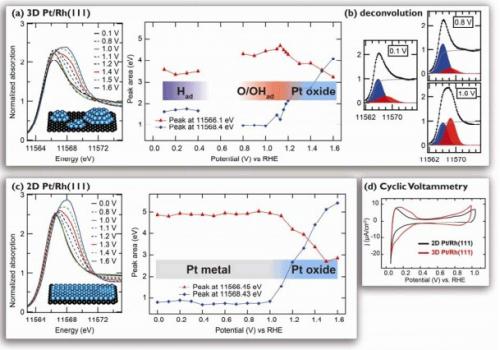Changing the electronic structure of a metal in order to “tune” its affinity to catalytic reaction intermediates is a key element in catalyst design. Tailor-made catalysts with a carefully adjusted ratio of two or more different alloy components are particularly needed in fuel cells, which could efficiently power electric vehicles – without the range limitations of current batteries. Both convert chemically stored energy into electricity, but in batteries this storage is limited to the electrode materials themselves, while fuel cells draw hydrogen or methanol from a tank and oxygen from air.
While the overall chemical reaction in a fuel cell is the same as in a combustion engine, its energy conversion is much more efficient since the reaction is separated in oxidation of the fuel at the anode, and the oxygen reduction reaction (ORR) at the cathode; the reaction free enthalpy is therefore directly converted into electricity. However, especially for the ORR an extremely careful design of catalyst materials is needed in order to meet two requirements: high catalytic activity to minimize costly use of its active component, Pt, and, at the same time, high stability to prevent catalyst degradation during long-term operation in a corrosive environment.
Bimetallic ORR catalysts exhibit expanded or compressed Pt–Pt distances (strain effect) as well as orbital interactions between Pt and the other metal (ligand effect); both effects change the chemisorption energy of atomic oxygen. The catalytic ORR activity correlates with the latter in a “volcano” relationship and becomes maximal when O is bound ~0.2 eV more weakly than on Pt(111).
Unfortunately, most often attempts to meet both requirements of high ORR activity and catalyst stability have failed, since the most active catalysts, e.g., Pt3Ni2 are not stable enough and, conversely, the most stable catalysts have only poor ORR activity.
Recently, SIMES and SUNCAT researchers joined their efforts and examined the “tuning” of a bimetallic fuel cell catalyst using well-defined model systems, consisting of ultrathin Pt layers grown on a single-crystal Rh(111) substrate. They discovered that the discrepancy between catalyst activity and stability could be overcome if, in addition to its elemental composition, its nanostructure is made a design criterion.
The SIMES team, led by Associate Staff Scientist Daniel Friebel, probed the nanostructure of Pt/Rh(111) model catalysts using the grazing incidence x-ray absorption fine structure (GI-XAFS) technique at SSRL Beam Line 11-2. It was found that a small Pt amount that corresponds to a single atomic layer can be grown on the Rh substrate in two different ways, resulting either in three-dimensional Pt islands (3D Pt/Rh(111)) or in a uniform two-dimensional Pt monolayer (2D Pt/Rh(111)). Both structures were then examined in 0.01 M HClO4 electrolyte at various electrochemical potentials with x-ray absorption spectroscopy (XAS) using the high energy resolution fluorescence detection (HERFD) mode at SSRL Beam Line 6-2. Uwe Bergmann supported this experiment with a unique setup of Bragg analyzer crystals for the HERFD technique, which allows for the in situ detection of chemisorbed oxygen species (O/OHad) whose spectral signatures would be too subtle to be resolved with conventional XAS. Due to their different nanostructures, the two samples showed markedly different behavior: 3D Pt/Rh(111) exhibited a much greater affinity to O/OHad than the 2D Pt/Rh(111), with O/OHad almost completely absent on the latter (Fig. 1).

